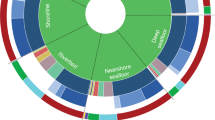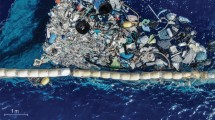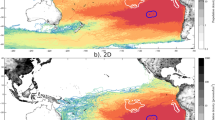Abstract
Riverine systems act as converging pathways for discarded litter within drainage basins, becoming key elements in gauging the transfer of mismanaged waste into the ocean. However, riverine litter data are scarce and biased towards microplastics, generally lacking information about larger items. Based on the first ever database of riverine floating macrolitter across Europe, we have estimated that between 307 and 925 million litter items are released annually from Europe into the ocean. The plastic fraction represented 82% of the observed litter, mainly fragments and single-use items (that is, bottles, packaging and bags). Our modelled estimates show that a major portion of the total litter loading is routed through small-sized drainage basins (<100 km2), indicating the relevance of small rivers, streams and coastal run-off. Moreover, the major contribution of high-income countries to the macrolitter inputs suggests that reducing ocean pollution cannot be achieved only by improving waste management, but also requires changing consumption habits and behaviour to curb waste generation at source. The inability of countries with well-developed recovery systems to control the leakage of waste into the environment further supports the need to regulate the production and use of plastic on a global scale.
This is a preview of subscription content, access via your institution
Access options
Access Nature and 54 other Nature Portfolio journals
Get Nature+, our best-value online-access subscription
$29.99 / 30 days
cancel any time
Subscribe to this journal
Receive 12 digital issues and online access to articles
$119.00 per year
only $9.92 per issue
Buy this article
- Purchase on Springer Link
- Instant access to full article PDF
Prices may be subject to local taxes which are calculated during checkout





Similar content being viewed by others
Data availability
The data that support the findings of this study are available at https://marinelitterlab.eu/ and from the corresponding author upon request. Datasets include a GIS shapefile for the estimates of ‘annual floating macrolitter loading’ (FML) obtained in the modelling output.
Change history
21 October 2022
A Correction to this paper has been published: https://doi.org/10.1038/s41893-022-01009-0
References
Communication from the Commission to the European Parliament, the Council, the European Economic and Social Commitee and the Committee of the Regions. A European Strategy for Plastics in a Circular Economy (European Commission, 2018).
GESAMP Sources, Fate and Effects of Microplastics in the Marine Environment: Part 2 of a Global Assessment (eds Kershaw, P. J. et al.) (International Maritime Organization, 2016).
NOAA NOAA Marine Debris Program, Strategic Plan 2016 - 2020 (US Department of Commerce, National Oceanic and Atmospheric Administration, National Ocean Service, Office of Response and Restoration, Marine Debris Division, 2015); https://marinedebris.noaa.gov/
Marine Plastic Debris and Microplastics: Global Lessons and Research to Inspire Action and Guide Policy Change (United Nations Environment Programme, 2016).
Geyer, R., Jambeck, J. R. & Law, K. L. Production, uses, and fate of all plastics ever made. Sci. Adv. 3, e1700782 (2017).
Lebreton, L. & Andrady, A. Future scenarios of global plastic waste generation and disposal. Palgrave Commun. 5, 6 (2019).
Lau, W. W. Y. et al. Evaluating scenarios toward zero plastic pollution. Science 369, 1455–1461 (2020).
Rillig, M. C. & Lehmann, A. Microplastic in terrestrial ecosystems. Science 368, 1430–1431 (2020).
Huerta Lwanga, E. et al. Field evidence for transfer of plastic debris along a terrestrial food chain. Sci. Rep. 7, 14071 (2017).
Jambeck, J. R. et al. Plastic waste inputs from lansd into the ocean. Science 347, 768–771 (2015).
Lebreton, L. C. M. et al. River plastic emissions to the world’s oceans. Nat. Commun. 8, 15611 (2017).
Schmidt, C., Krauth, T. & Wagner, S. Export of plastic debris by rivers into the sea. Environ. Sci. Technol. 51, 12246–12253 (2017).
Dris, R. et al. Beyond the ocean: contamination of freshwater ecosystems with (micro-)plastic particles. Environ. Chem. 12, 539–550 (2015).
Breuninger, E. et al. Plastics in European freshwater environments. In Conference on Plastics in Freshwater Environments (eds Bänsch-Baltruschat, B. et al.) 16–71 (Umweltbundesamt, 2017).
van Emmerik, T., Strady, E., Kieu-Le, T.-C., Nguyen, L. & Gratiot, N. Seasonality of riverine macroplastic transport. Sci. Rep. 9, 13549 (2019).
Vriend, P. et al. Rapid assessment of floating macroplastic transport in the Rhine. Front. Mar. Sci. 7, 10 (2020).
Schöneich-Argent, R. I., Dau, K. & Freund, H. Wasting the North Sea? – A field-based assessment of anthropogenic macrolitter loads and emission rates of three German tributaries. Environ. Pollut. 263, 114367 (2020).
Eriksen, M. et al. Plastic pollution in the world’s oceans: more than 5 trillion plastic pieces weighing over 250,000 tons afloat at sea. PLoS ONE 9, e111913 (2014).
González, D. et al. Riverine Litter Monitoring - Options and Recommendations (Joint Research Centre, European Commission, 2016); https://doi.org/10.2788/461233
Moore, C. J., Lattin, G. L. & Zellers, A. F. Quantity and type of plastic debris flowing from two urban rivers to coastal waters and beaches of Southern California. Rev. Gest. Cost. Integr. 11, 65–73 (2011).
Carson, H. S. et al. Tracking the sources and sinks of local marine debris in Hawaii. Mar. Environ. Res. 84, 76–83 (2013).
Crosti, R., Arcangeli, A., Campana, I., Paraboschi, M. & González-Fernández, Z. ‘Down to the river’: amount, composition, and economic sector of litter entering the marine compartment, through the Tiber river in the Western Mediterranean Sea. Rend. Lincei Sc. Fis. Nat. 29, 859–866 (2018).
Castro-Jiménez, J., González-Fernández, D., Fornier, M., Schmidt, N. & Sempéré, R. Macro-litter in surface waters from the Rhone River: plastic pollution and loading to the NW Mediterranean Sea. Mar. Pollut. Bull. 146, 60–66 (2019).
González-Fernández, D. & Hanke, G. Toward a harmonized approach for monitoring of riverine floating macro litter inputs to the marine environment. Front. Mar. Sci. 4, 86 (2017).
van Emmerik, T. et al. Seine plastic debris transport tenfolded during increased river discharge. Front. Mar. Sci. 6, 642 (2019).
Directive 2008/56/EC of the European Parliament and of the Council of 17 June 2008 Establishing a Framework for Community Action in the Field of Marine Environmental Policy (Marine Strategy Framework Directive) (European Commission, 2008).
Directive 2000/60/EC of the European Parliament and of the Council of 23 October 2000 Establishing a Framework for Community Action in the Field of Water Policy (European Commission, 2000).
Directive (EU) 2019/904 on the Reduction of the Impact of Certain Plastic Products on the Environment (European Commission, 2019).
European Commission, Joint Research Centre, Columbia University & CIESIN GHS population grid, derived from GPW4, multitemporal (1975, 1990, 2000, 2015) (Joint Research Centre, European Commission, 2015); http://data.europa.eu/89h/jrc-ghsl-ghs_pop_gpw4_globe_r2015a
De Jager, A. & Vogt, J. Rivers and Catchments of Europe - Catchment Characterisation Model (CCM) (Joint Research Centre, European Commission, 2007); http://data.europa.eu/89h/fe1878e8-7541-4c66-8453-afdae7469221
Pierdomenico, M., Casalbore, D. & Chiocci, F. L. Massive benthic litter funnelled to deep sea by flash-flood generated hyperpycnal flows. Sci. Rep. 9, 5330 (2019).
Cózar, A. et al. Plastic accumulation in the Mediterranean Sea. PLoS ONE 10, e0121762 (2015).
Hurley, R., Woodward, J. & Rothwell, J. J. Microplastic contamination of river beds significantly reduced by catchment-wide flooding. Nat. Geosci. 11, 251–257 (2018).
Axelsson, C. & van Sebille, E. Prevention through policy: urban macroplastic leakages to the marine environment during extreme rainfall events. Mar. Pollut. Bull. 124, 211–227 (2017).
Small, C. & Nicholls, R. J. A global analysis of human settlement in coastal zones. J. Coast. Res. 19, 584–599 (2003).
Grill, G. et al. Mapping the world’s free-flowing rivers. Nature 569, 215–221 (2019).
Danube River Basin District: Part A – Basin-Wide Overview (ICPDR, 2005): https://www.icpdr.org/main/sites/default/files/nodes/documents/danube_basin_analysis_2004.pdf
Tramoy, R. et al. Assessment of the plastic inputs from the Seine basin to the sea using statistical and field approaches. Front. Mar. Sci. 6, 151 (2019).
Schmidt, C., Krauth, T. & Wagner, S. Correction to export of plastic debris by rivers into the sea. Environ. Sci. Technol. 52, 927 (2018).
Kataoka, T. & Nihei, Y. Quantification of floating riverine macro-debris transport using an image processing approach. Sci. Rep. 10, 2198 (2020).
Lieshout, C., Oeveren, K., Emmerik, T. & Postma, E. Automated river plastic monitoring using deep learning and cameras. Earth Space Sci. 7, e2019EA000960 (2020).
Brooks, A. L., Wang, S. & Jambeck, J. R. The Chinese import ban and its impact on global plastic waste trade. Sci. Adv. 4, 131 (2018).
Galgani, F. et al. Guidance on Monitoring of Marine Litter in European Seas (Joint Research Centre, European Commission, 2013); https://doi.org/10.2788/99475
González-Fernández, D., Hanke, G. & RiLON Floating Macro Litter in European Rivers - Top Items (European Commission, 2018); https://doi.org/10.2760/316058
Schirinzi, G. F. et al. Riverine anthropogenic litter load to the Mediterranean Sea near the metropolitan area of Barcelona, Spain. Sci. Total Environ. 714, 136807 (2020).
European Catchments and Rivers Network System (Ecrins) (European Environment Agency, 2012); https://www.eea.europa.eu/data-and-maps/data/european-catchments-and-rivers-network
Country Boundaries. Admin 0 – Countries v4.1.0 (Natural Earth, 2021); www.naturalearthdata.com
Hoornweg, D. & Bhada-Tata, P. What a Waste: A Global Review of Solid Waste Management (World Bank Group, 2012); http://hdl.handle.net/10986/17388
Davison, A. C. & Hinkley, D. V. Bootstrap Methods and their Application (Cambridge Univ. Press, 1997); https://doi.org/10.1017/CBO9780511802843
Europe Seas (European Environment Agency, 2021); https://www.eea.europa.eu/data-and-maps/data/europe-seas-1
Acknowledgements
We acknowledge the additional members (coordinators and observers) of RiLON, listed in Supplementary Data 5, for their support in the field data collection and feedback during the data quality control. D.G.-F. was supported by the JRC institutional exploratory project RIMMEL (272346), PLASTREND (BBVA Foundation) and the European Union (H2020-MSCA-IF-2018 846843 - LitRivus). J.V. and C.M.-C. were supported by the MIDaS project (Spanish Ministry of Science, Innovation and Universities, CTM2016-77106-R, AEI/FEDER/UE).
Author information
Authors and Affiliations
Contributions
D.G.-F., A.C. and G.H. conceived and drafted the present study; they contributed equally to the work. D.G.-F., A.C., J.V. and C.M.-C. analysed the data and prepared the results. The rest of the authors coordinated and participated in the field data collection and commented on the data quality assessment for the RIMMEL database. All authors read and commented on the manuscript.
Corresponding author
Ethics declarations
Competing interests
The authors declare no competing interests.
Additional information
Peer review information Nature Sustainability thanks the anonymous reviewers for their contribution to the peer review of this work.
Publisher’s note Springer Nature remains neutral with regard to jurisdictional claims in published maps and institutional affiliations.
Supplementary information
Supplementary Information
Supplementary Methods, Figs. 1–5 and Table 1.
Supplementary Data
The file contains five spreadsheets (Supplementary Data 1–5) with the data used to produce the analyses and results presented in the main manuscript.
Rights and permissions
Springer Nature or its licensor (e.g. a society or other partner) holds exclusive rights to this article under a publishing agreement with the author(s) or other rightsholder(s); author self-archiving of the accepted manuscript version of this article is solely governed by the terms of such publishing agreement and applicable law.
About this article
Cite this article
González-Fernández, D., Cózar, A., Hanke, G. et al. Floating macrolitter leaked from Europe into the ocean. Nat Sustain 4, 474–483 (2021). https://doi.org/10.1038/s41893-021-00722-6
Received:
Accepted:
Published:
Issue Date:
DOI: https://doi.org/10.1038/s41893-021-00722-6
This article is cited by
-
Marine macro-litter sources and ecological impact: a review
Environmental Chemistry Letters (2024)
-
The Unseen Threat of the Synergistic Effects of Microplastics and Heavy Metals in Aquatic Environments: A Critical Review
Current Pollution Reports (2024)
-
Diverging estimates of river plastic input to the ocean
Nature Reviews Earth & Environment (2023)
-
River plastic transport and deposition amplified by extreme flood
Nature Water (2023)
-
Amsterdam urban water system as entry point of river plastic pollution
Environmental Science and Pollution Research (2023)



